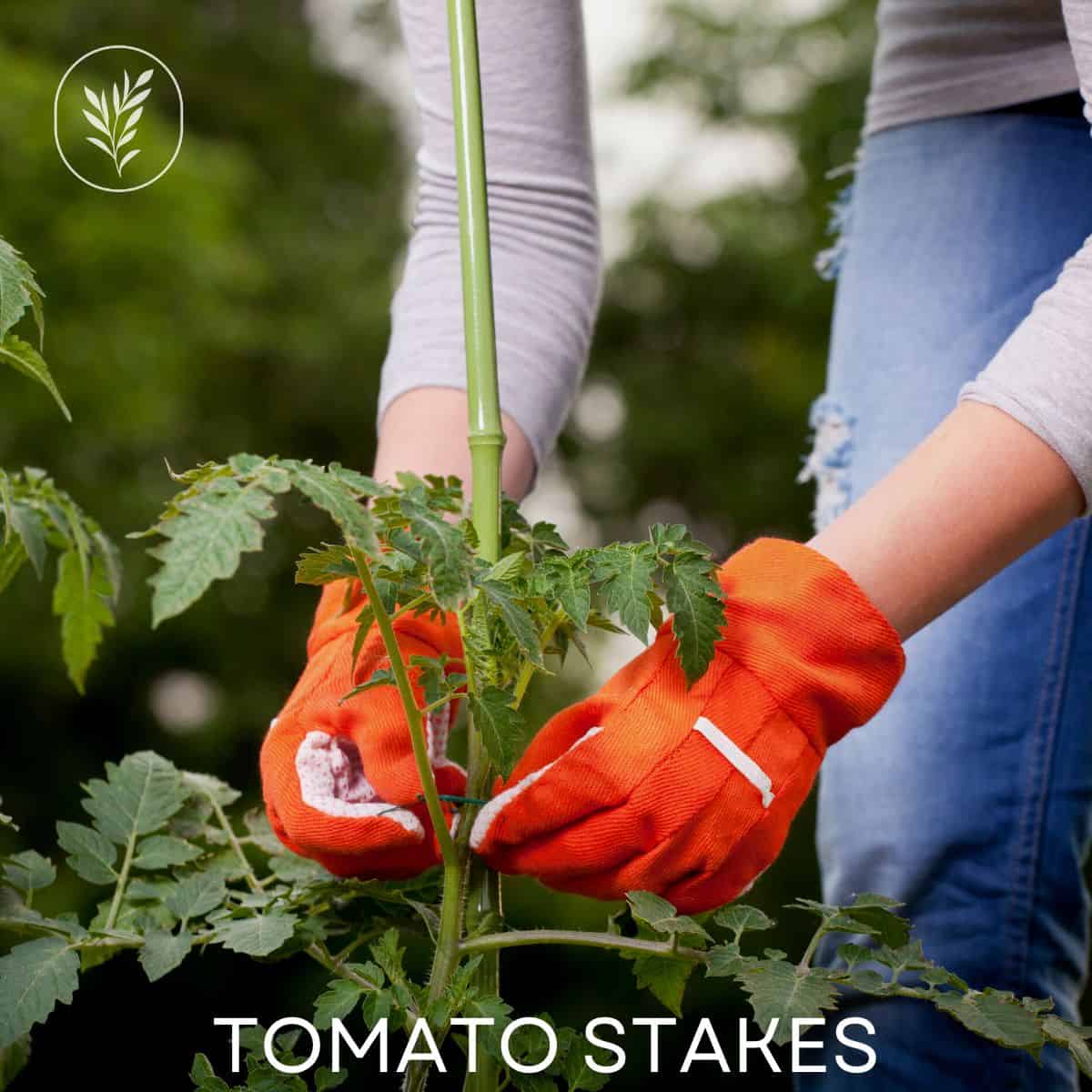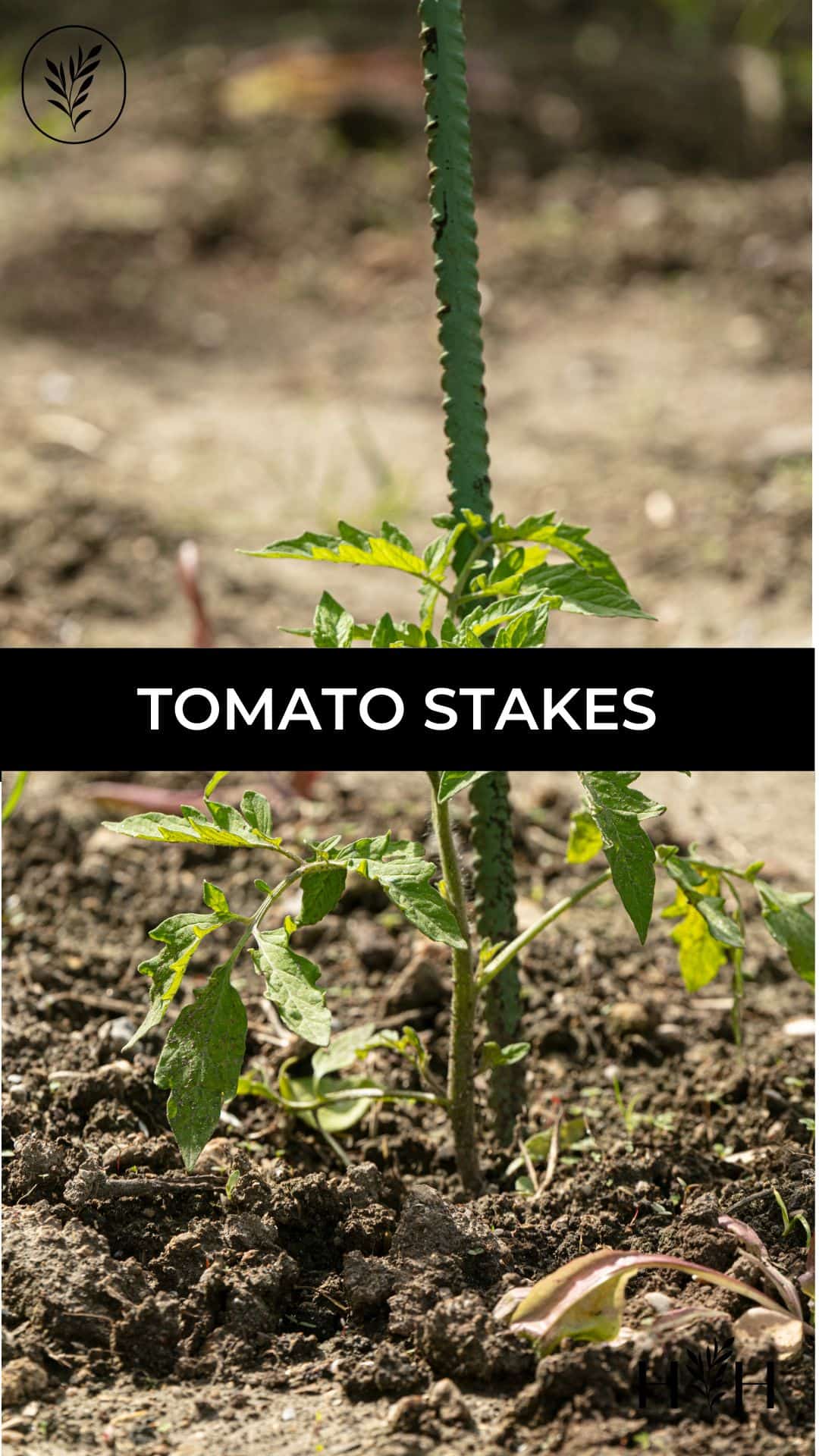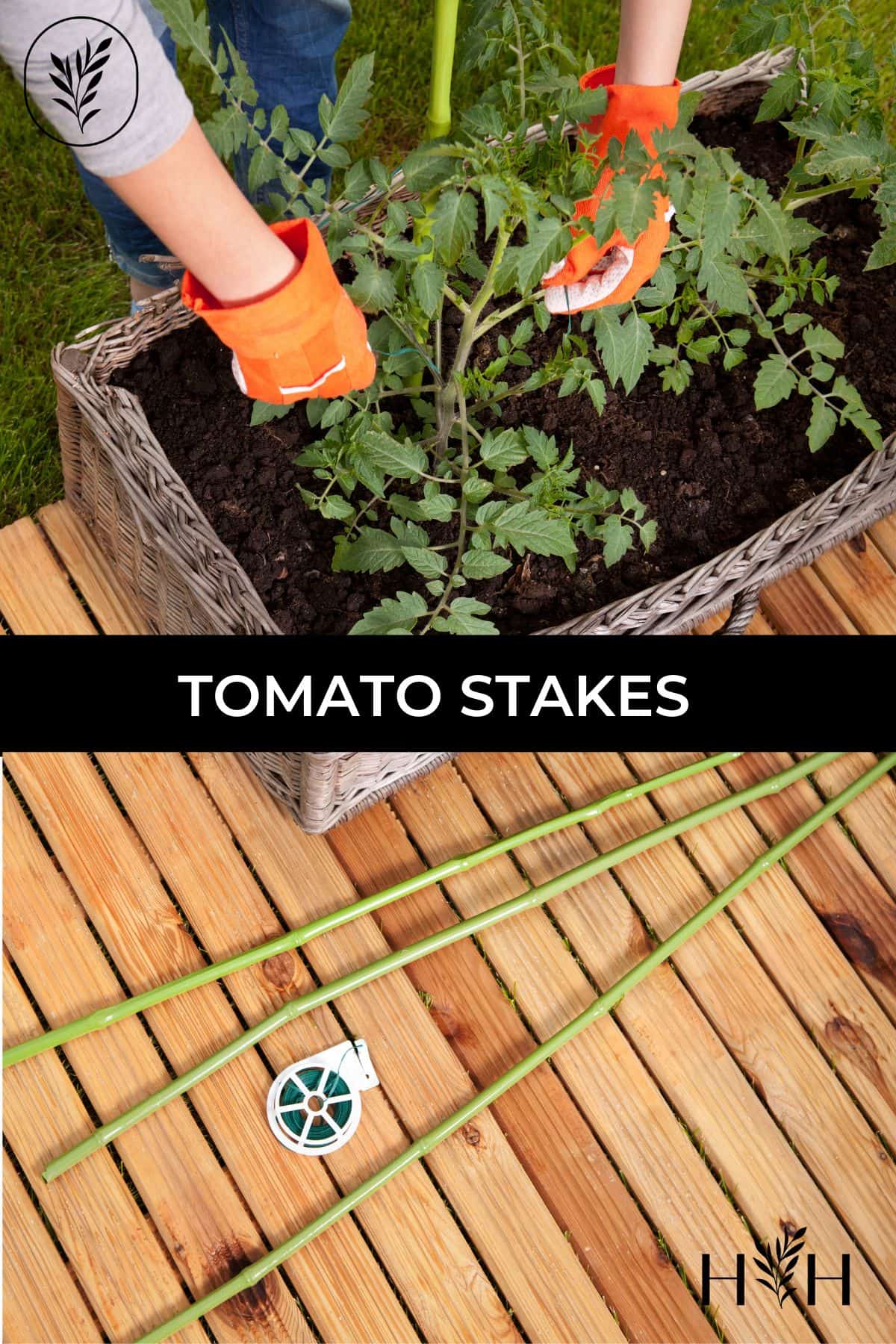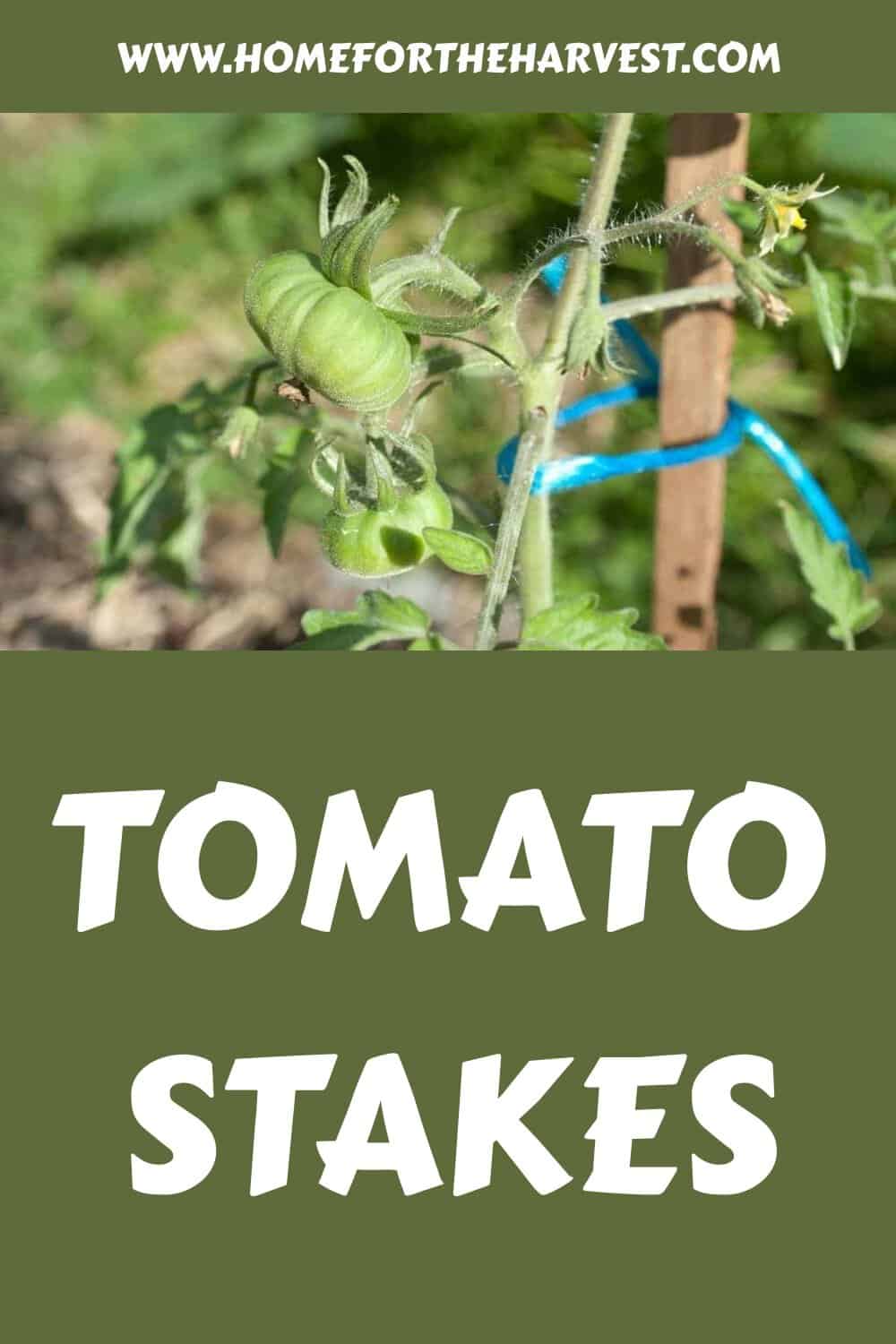While it’s possible to grow tomatoes without any type of vertical support, most gardeners opt to use a support structure like a tomato stake.
Tomato stakes are vertical poles placed beside seedling tomato plants to provide a minimal trellis for the growing vine. Growing tomato vines are then gently tied onto the stake to encourage the plant to grow vertically rather than sprawl along the ground. Vertical growing maximizes yield for garden space while decreasing the plant’s vulnerability to disease and tomato plant pests like slugs. Large tomato plants may require multiple stakes or may be better served with a heavy-duty tomato cage supported by stakes.
Read on to learn all about tomato stakes!
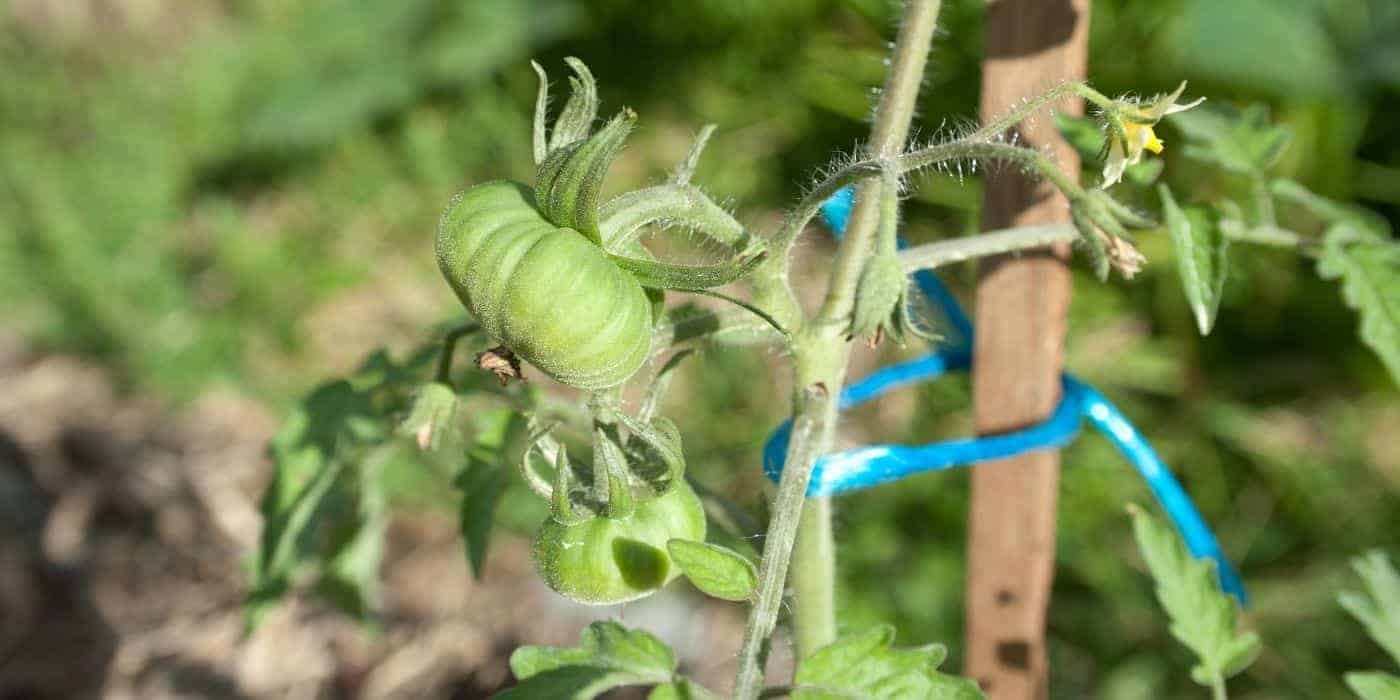
Tomato stake basics
Tomato plants grow best with something to climb – like a tomato stake. While the most supportive option is to use a tomato cage, getting tomato stakes set up is generally cheaper and quicker. Even gardeners who use heavy-duty tomato cages generally use tomato stakes to anchor the cages in place.
Why stake tomato plants?
Most types of tomato plants are more productive and healthy if staked. While some compact determinate varieties can grow without vertical support, all indeterminate varieties (the majority of types) should be staked or caged. Indeterminate tomato plants grow continuously longer and do not have the natural upright habit of determinate tomato plants. These long-vining types need some type of support for optimal results in the garden.
Tomato plants grow as long, as sprawling vines and tend to grow along the ground if not supported. Stakes keep the leaves off of the ground (and the tomatoes away from hungry critters). This helps provide better air circulation and reduces rot and soil-borne disease. A metal stake, rod, or piece of bamboo can also provide support during summer storms (especially if the plants are laden with heavy fruit).
Some tomato varieties that use a tomato stake are:
- Brandywine Tomatoes
- Black Krim Tomatoes
- Mortgage Lifter Tomatoes
- SunGold Tomatoes
- Cherokee Purple Tomatoes
- San Marzano Tomatoes
- Beefsteak Tomatoes
- Green Zebra Tomatoes
- The Kellogg’s Breakfast Tomatoes
- Roma Tomatoes
- Pineapple Tomatoes
- Early Girl Tomatoes
- Big Boy Tomatoes
- Better Boy Tomatoes
- Brandy Boy Tomatoes
- Big Beef Tomatoes
- Celebrity Tomatoes
- Arkansas Traveler Tomatoes
- Aunt Ruby’s German Green Tomatoes
- German Queen Tomatoes
- Carbon Tomatoes
- Juliet Tomatoes
- Sweet 100 Tomatoes
- Sweet Million Tomatoes
- Sun Sugar Tomatoes
- Black Cherry Tomatoes
- Yellow Pear Tomatoes
- Pomato Plant
Choosing tomato stakes
Tomato stakes can be made with many different materials, including coated metal, wood, plastic, or bamboo. Stakes should be strong enough to hammer into the soil without bending or breaking. They’ll also need to withstand strong summer winds and the weight of full-grown tomato fruits on the vines. Metal tomato stakes tend to last the longest.
While some tomato plants are just fine with one stake, some monstrous indeterminate tomatoes may need several stakes. Many gardeners using tomato stakes (instead of heavy-duty tomato cages) tend to prune their tomato plants to keep them somewhat under control. DIY options can be made from T-posts, reinforcing rods, or other sturdy poles.
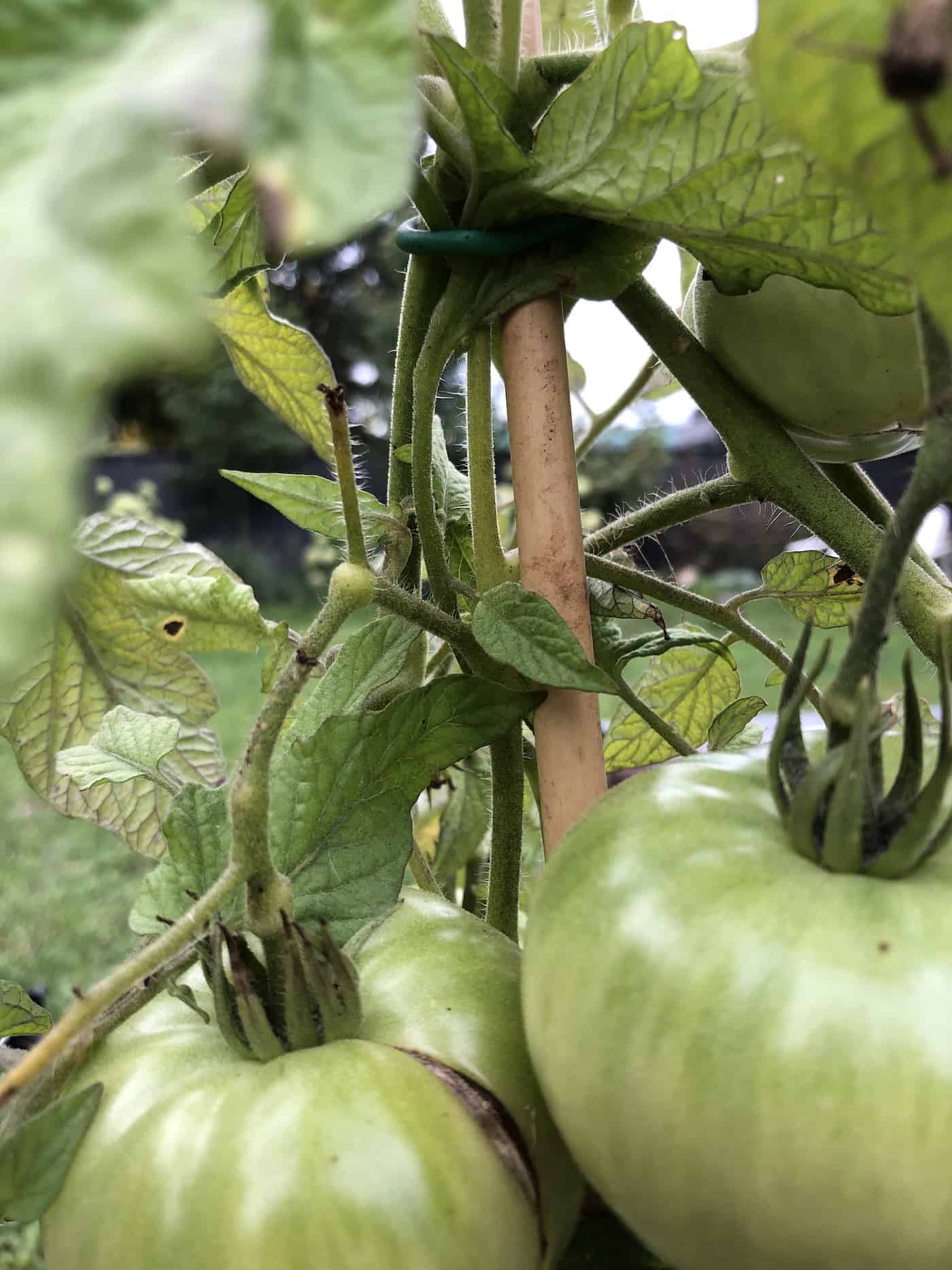
Tomato stake length
Tomato stakes should be a minimum of 5′ tall and potentially up to 10′ tall if available locally. Most gardeners drive tomato stakes into the ground by a foot or two, which reduces the above-ground length available to the plant.
Here are some expert tips on choosing a height for your tomato stakes:
“The vast majority of tomato varieties benefit from being staked. For indeterminate tomatoes, the taller the stake, the better; such varieties will easily reach 8 feet or more by the end of a growing season. Dwarf and determinate tomatoes, which can grow up to 4 feet, require a stake of equal height to keep them from sprawling.”
Epic Tomatoes: How to Select and Grow the Best Varieties of All Time, by Craig LeHoullier
“If staking is the support of choice, it should be done very soon after transplanting to avoid damage to rapidly expanding root systems. The requirement for stake height will be different for different varieties of tomatoes, but a standard height is about 6 feet tall with roughly 10 to 12 inches of the stake underground. Decay-resistant wood is best and can be reused for multiple seasons.”
The Complete Guide to Growing Tomatoes: Everything You Need to Know Explained Simply — Including Heirloom Tomatoes, by Cherie Everhart
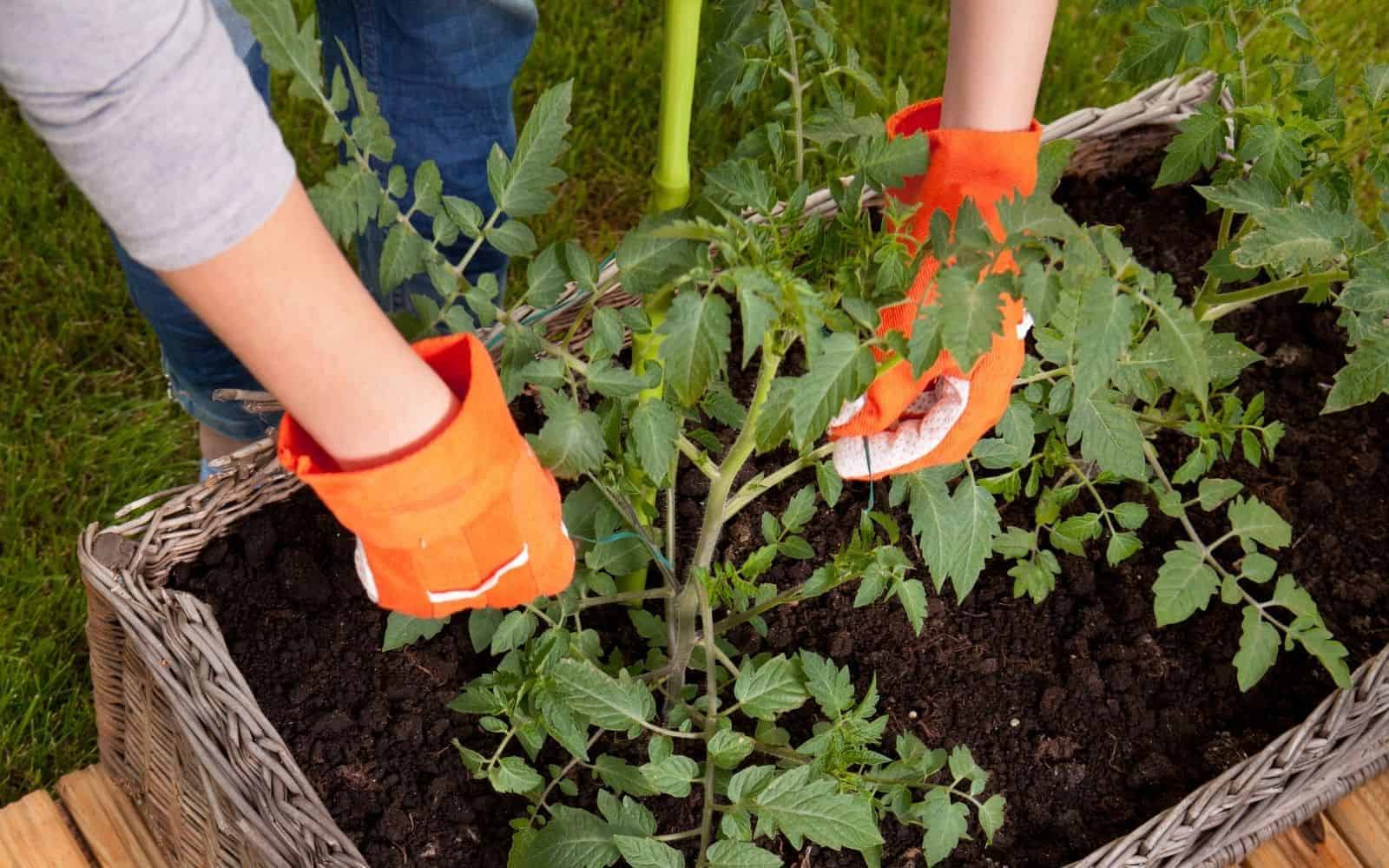
How to stake tomato plants
The best way to stake up tomato plants is to install the tomato stake when the tiny tomato plant is first transplanted out into the outdoor garden. Delaying stake installation can lead to root disruption when the stake is finally pounded in. The vine will also climb the stake more naturally when the stake is inserted early. Try to stake your seedling tomato plants rather than waiting until they are larger (as the delay can lead to root damage during later installation). Most plants can be supported with a single stake.
Many purpose-built tomato stakes come with a pointy end so they can be driven into the ground. Each tomato stake is different, but some gardeners use wooden or rubber mallets to drive them into the ground. Driving stakes into the ground is easiest in raised garden beds or high-quality garden soil. Place the stake about 3″-6″ from the stem of the tomato plant.
“…most people at least stake their tomatoes. They drive a six- or eight-foot (2- or 2.5-meter) stake deep into the ground, leaving only four to six feet (1 to 2 meters) aboveground, and then gently (and continually, as the plant grows) secure the main tomato vine to that stake with something that won’t cut into the vine and sever it under pressure…”
You Bet Your Garden Guide to Growing Great Tomatoes: How to Grow Great-Tasting Tomatoes in Any Backyard, Garden, or Container, by Mike McGrath
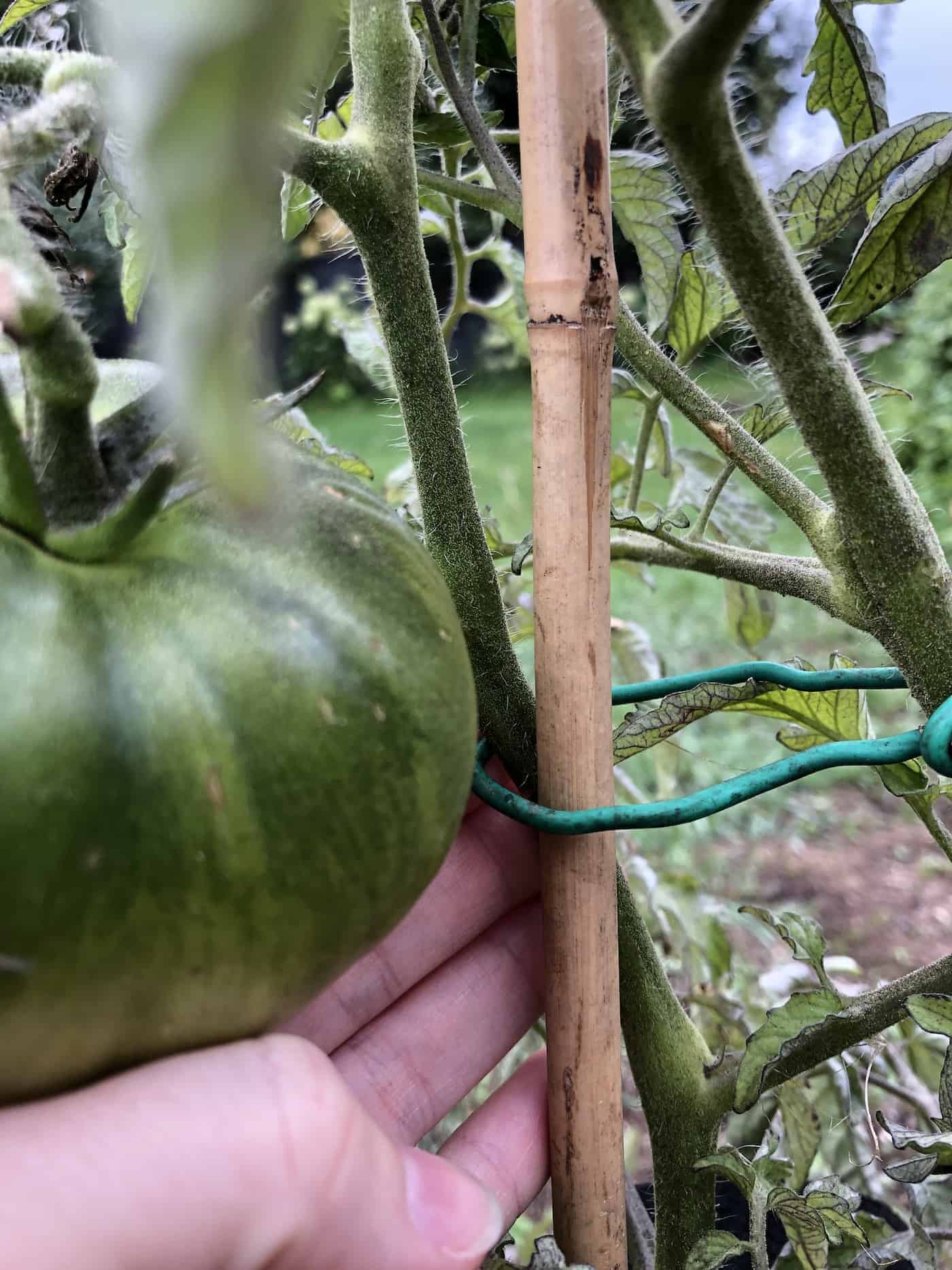
How to tie up tomato plants to stakes
Tomato plants typically need to be tied to tomato stakes. They rarely climb the stakes themselves and are instead attached by the gardeners with twine or tomato tie products. Start by identifying the main stem of the tomato plant.
Tomato vines should be tied up with a soft material that will not cut into the soft vines. Avoid wire, opting instead for strips of fabric, sisal twine, or store-bought tomato ties.
Loosely tie the main stem of the tomato transplant to the tomato stake, about 6″ up from the soil surface. Continue to watch the tomato plant as it grows, adding more ties at 6″-12″ intervals as the plant grows upwards. Some gardeners will choose 2 main stems to tie to the stake, but avoid any more main vertical stems as this can crowd the foliage and reduce air circulation.
Those growing multiple tomato plants may choose an alternate method of tying up tomatoes called “The Florida Weave”. In this support method, stakes are installed between tomato plants rather than immediately beside them. Long lengths of twine are then strung horizontally between adjacent stakes – on both sides of each tomato plant. Growers usually use several lengths of horizontal twine at various heights to firmly sandwich and secure the plants in the fence-like structure.
“Tomatoes are referred to as vining plants, but they don’t climb by automatically attaching themselves as they grow, as ivy or morning glories do. They need to be continually secured to the vertical support using ties made of relatively soft material, such as sisal twine. Make the initial tie of the vine to the stake at 6 inches above the soil.”
Epic Tomatoes: How to Select and Grow the Best Varieties of All Time, by Craig LeHoullier
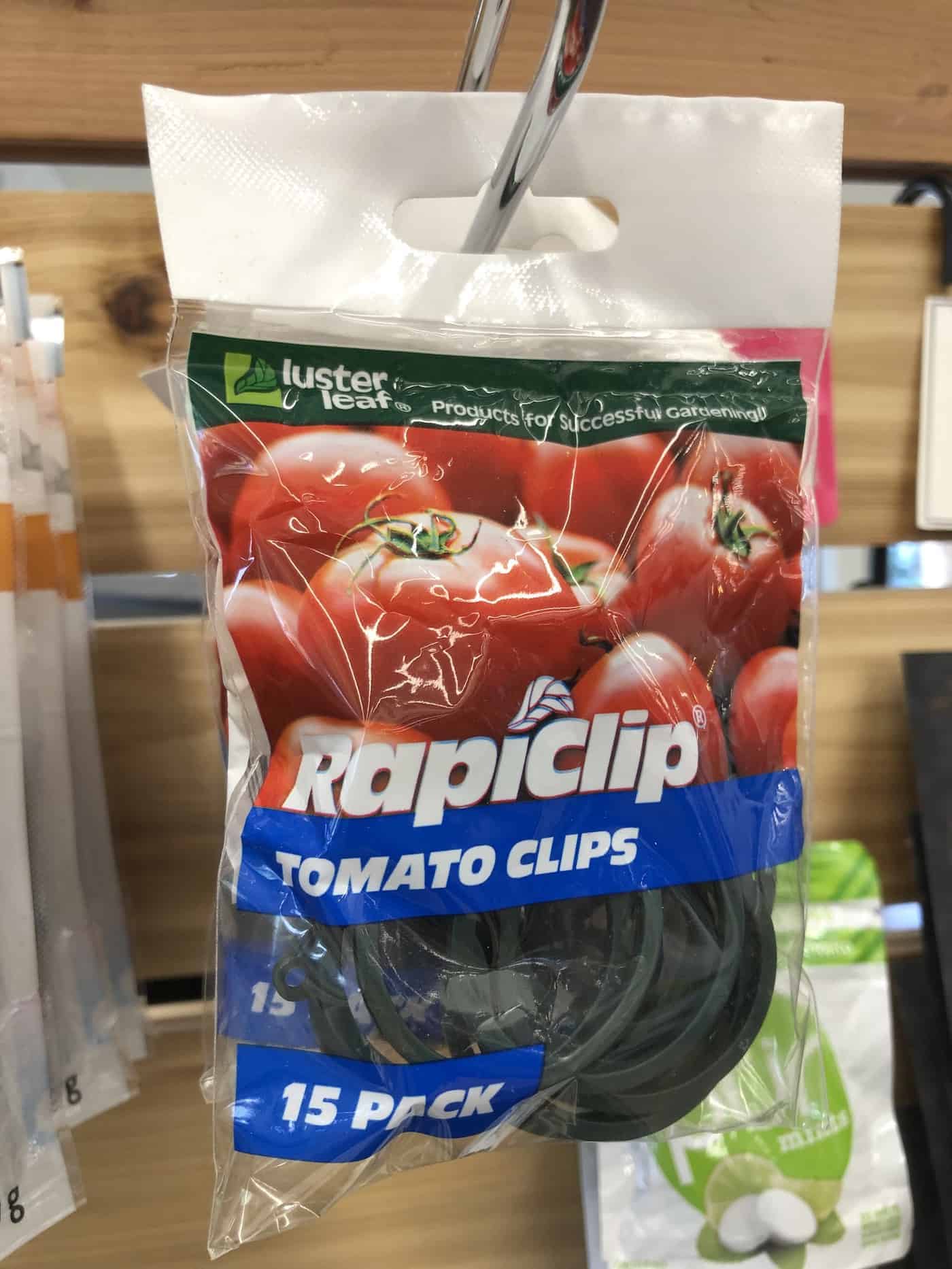
Is it better to stake or cage tomatoes?
Caging tomatoes generally leads to healthier plants and more tomatoes than staking tomato plants. Cages are, however, more expensive and time-intensive to set up. Staked tomato plants tend to require more maintenance during the growing season than caged tomato plants. Whether using stakes or a cage, install the vertical support soon after planting the tomato seedling rather than waiting for it to mature.
Staking tomatoes is the best option for those looking to minimize spend, minimize set-up time, and grow tomatoes in a space-restricted area. Tomato stakes are low-cost, quick to install, and fit into small spaces. Tomatoes grown with stakes do take a bit more work than caged tomatoes on a day-to-day basis, as the stems must be tied to the stake and vines sometimes require pruning to keep the plant from sprawling. Sometimes a second stake must be added later on for extra stability as the vines grow.
Caging tomatoes is the best option for those looking to maximize production and minimize day-to-day work. Tomato cages are typically more expensive to purchase than stakes (especially since they generally require stakes of their own to anchor). Many heavy-duty cages are made of animal fencing or concrete reinforcing mesh. Once the cages are in place, the tomato plants don’t require tying or pruning. Tomato cages are the best option for those looking for a heavy-duty long-term solution for growing healthy tomato plants.
“Fishing line and piano wire are exceptionally poor choices for tying up tomatoes. Twist ties can be risky as well, because they have wire inside. Strips of soft cloth or foam or a commercial “tie-your-tomatoes-up” product are much better. But better still would be to reject this foolish path and instead “cage ’em and forget ’em.”
You Bet Your Garden Guide to Growing Great Tomatoes: How to Grow Great-Tasting Tomatoes in Any Backyard, Garden, or Container, by Mike McGrath
Pruning staked tomato plants
While tomato plants grown in tomato cages typically do not need pruning, tomato plants grown up a vertical tomato stake will likely benefit from careful pruning. Watch for suckers developing at the base of stems and prune off the suckers when young.
Take note of the main central vine on the plant while it is young, as well as the main fruiting branches (side stems). If any stems start to become thick like the main vine, they can be removed (rather than tied up the stake along with the main vine). A stake can usually support 1-2 main tomato vines but can become crowded if there are 3-4 vertical vines tied to the stem. Remove extra vines to allow for air circulation around the main vine (or a maximum of 2 vertical main vines).
“When staking, some pruning is probably best to better manage the plant. Pruning can help keep a plant reasonably well controlled , so that two main vines develop close to the base of the plant. Staking tomatoes is pretty simple and not very costly, but it can be somewhat time and labor intensive as the tomato plants grow. It is necessary to tie and re-tie vines and branches on a weekly basis and to salvage the occasional toppled stake and plant that fall after a major storm.”
The Complete Guide to Growing Tomatoes: Everything You Need to Know Explained Simply — Including Heirloom Tomatoes, by Cherie Everhart


